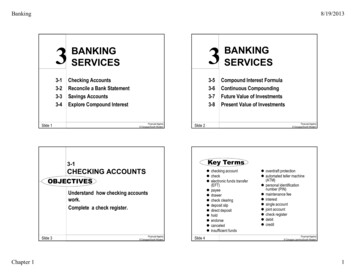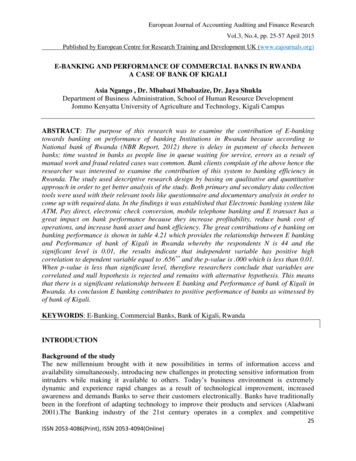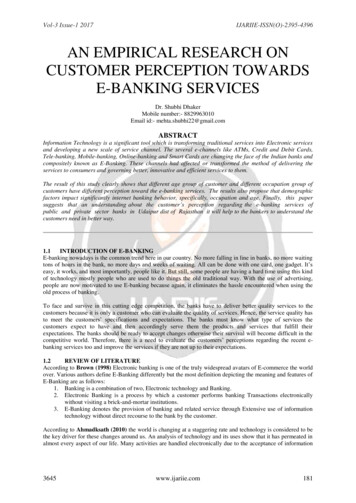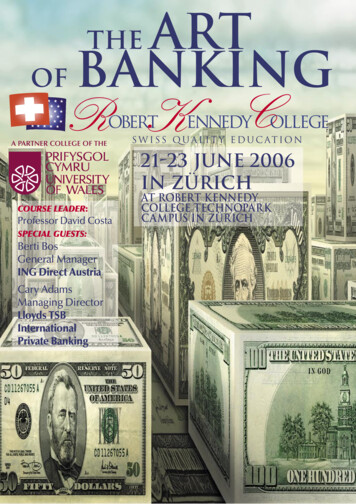
Transcription
ing AccountsReconcile a Bank StatementSavings AccountsExplore Compound Interest3-53-63-73-8Financial Algebra Cengage/South-WesternSlide 1Financial Algebra Cengage/South-WesternKey TermsCHECKING ACCOUNTS checking account check electronic funds transfer(EFT) payee drawer check clearing deposit slip direct deposit hold endorse canceled insufficient fundsOBJECTIVESUnderstand how checking accountswork.Complete a check register.Chapter 1Compound Interest FormulaContinuous CompoundingFuture Value of InvestmentsPresent Value of InvestmentsSlide 23-1Slide 3BANKINGSERVICESFinancial Algebra Cengage/South-WesternSlide 4 overdraft protection automated teller machine(ATM) personal identificationnumber (PIN) maintenance fee interest single account joint account check register debit creditFinancial Algebra Cengage Learning/South-Western1
Banking8/19/2013How do people gain access tomoney they keep in the bank? What are the responsibilities of having achecking account? What are the ways that account holders accessthe money in their checking accounts? Why might a person need overdraft protection? Is overdraft protection a form of a loan from abank? Why is it important to use a check register?Financial Algebra Cengage Learning/South-WesternSlide 5Example 1Allison currently has a balance of 2,300 in herchecking account. She deposits a 425.33paycheck, a 20 rebate check, and a personalcheck for 550 into her checking account. Shewants to receive 200 in cash. How much will shehave in her account after the transaction?Example 2CHECK YOUR UNDERSTANDINGNick has a checking account with the Park Slope SavingsBank. He writes both paper and electronic checks. For eachtransaction, Nick enters the necessary information: checknumber, date, type of transaction, and amount. He uses E toindicate an electronic transaction. Determine the balance inhis account after the Star Cable Co. check is written.Lizzy has a total of x dollars in her checking account.She makes a deposit of b dollars in cash and twochecks each worth c dollars. She would like d dollarsin cash from this transaction. She has enough tocover the cash received in her account. Express hernew checking account balance after the transactionas an algebraic expression.Slide 7Chapter 1Financial Algebra Cengage Learning/South-WesternSlide 6Financial Algebra Cengage Learning/South-WesternSlide 8Financial Algebra Cengage Learning/South-Western2
Banking8/19/2013CHECK YOUR UNDERSTANDINGEXTEND YOUR UNDERSTANDINGNick writes a check to his friend James Sloan on May11 for 150.32. What should he write in the checkregister and what should the new balance be?Would the final balance change if Nick had paid thecable bill before the wireless bill? Explain.Financial Algebra Cengage Learning/South-WesternSlide 93-2RECONCILE A BANKSTATEMENTKey TermsOBJECTIVESReconcile a checking account with abank statement by hand and by using aspreadsheet.Slide 11Chapter 1Financial Algebra Cengage Learning/South-WesternSlide 10Financial Algebra Cengage/South-Western Slide 12account numberbank statementstatement periodstarting balanceending balance outstanding depositsoutstanding checksbalancingreconcilingFinancial Algebra Cengage Learning/South-Western3
Banking8/19/2013How do checking account users make sure thattheir records are correct? Why is it important to reconcile the checkregister monthly? What problems could arise if you think youhave more in your account than the bankknows you have?Slide 13Financial Algebra Cengage Learning/South-WesternExample 1The next slide has a bank statement and checkregister for Michael Biak’s checking account.What steps are needed to reconcile Michael’sbank statement?Financial Algebra Cengage Learning/South-WesternSlide 14CHECK YOUR UNDERSTANDINGName some reasons why a check may not havecleared during the monthly cycle and appear on thebank statement.Slide 15Chapter 1Financial Algebra Cengage Learning/South-WesternSlide 16Financial Algebra Cengage Learning/South-Western4
Banking8/19/2013Example 2Use algebraic formulas and statements to model thecheck register balancing process.Slide 17Financial Algebra Cengage Learning/South-WesternEXAMPLE 3Marina and Brian have a joint checking account. Theyhave a balance of 3,839.25 in the check register.The balance on the bank statement is 3,450.10. Notreported on the statement are deposits of 2,000, 135.67, 254.77, and 188.76 and four checks for 567.89, 23.83, 598.33, and 1,000. Reconcile thebank statement using a spreadsheet.Slide 19Chapter 1Financial Algebra Cengage Learning/South-WesternCHECK YOUR UNDERSTANDINGNancy has a balance of 1,078 in her check register. Thebalance on her bank account statement is 885.84. Notreported on her bank statement are deposits of 575 and 250 and two checks for 195 and 437.84. Is her checkregister balanced? Explain.Financial Algebra Cengage Learning/South-WesternSlide 18CHECK YOUR UNDERSTANDINGWrite a formula to calculate the sum of theoutstanding checks.Slide 20Financial Algebra Cengage Learning/South-Western5
Banking8/19/20133-3Key TermsSAVINGS ACCOUNTS OBJECTIVESLearn the basic vocabulary of savingsaccounts.Compute simple interest using thesimple interest formula.Slide 21Financial Algebra Cengage/South-WesternWhat types of savings accounts dobanks offer customers?Chapter 1 statement savingsminimum balancemoney market accountcertificate of deposit (CD)maturityFinancial Algebra Cengage Learning/South-WesternSlide 22Example 1Grace wants to deposit 5,000 in a certificate of depositfor a period of two years. She is comparing interestrates quoted by three local banks and one online bank.Write the interest rates in ascending order. Which bankpays the highest interest for this two-year CD? What banking services does your family use? Where does the money that banks lend out forloans come from? What is the value of compound interest? What are the advantages of direct deposit?Slide 23savings accountinterestinterest rateprincipalsimple interestsimple interest formulaFinancial Algebra Cengage Learning/South-Western1First State Bank: 4 4 %3E-Save Bank: 4 8 %Johnson City Trust: 4.22% Land Savings Bank: 4.3%Slide 24Financial Algebra Cengage Learning/South-Western6
Banking8/19/2013Example 2Raoul’s savings account must have at least 500, or heis charged a 4 fee. His balance was 716.23, when hewithdrew 225. What was his balance?CHECK YOUR UNDERSTANDINGWrite the following five interest rates indescending order (greatest to least):155.51%, 5 2 %, 5 8 %, 5.099%, 5.6%Financial Algebra Cengage Learning/South-WesternSlide 25CHECK YOUR UNDERSTANDINGMae has 891 in her account. A 7 fee is chargedeach month the balance is below 750. Shewithdraws 315. If she makes no deposits orwithdrawals for the next x months, express herbalance algebraically.Slide 27Chapter 1Financial Algebra Cengage Learning/South-WesternSlide 26Financial Algebra Cengage Learning/South-WesternEXAMPLE 3Mitchell deposits 1,200 in an account that pays 4.5%simple interest. He keeps the money in the account forthree years without any deposits or withdrawals. Howmuch is in the account after three years?Slide 28Financial Algebra Cengage Learning/South-Western7
Banking8/19/2013CHECK YOUR UNDERSTANDINGHow much simple interest is earned on 4,000 in 3½years at an interest rate of 5.2%?Financial Algebra Cengage Learning/South-WesternSlide 29CHECK YOUR UNDERSTANDINGHow much simple interest would 800 earn in 300days in a non-leap year at an interest rate of 5.71%?Round to the nearest cent.Slide 31Chapter 1Financial Algebra Cengage Learning/South-WesternEXAMPLE 4How much simple interest does 2,000 earn in 7months at an interest rate of 5%?Slide 30Financial Algebra Cengage Learning/South-WesternEXAMPLE 5How much principal must be deposited to earn 1,000simple interest in 2 years at a rate of 5%?Slide 32Financial Algebra Cengage Learning/South-Western8
Banking8/19/2013CHECK YOUR UNDERSTANDINGHow much principal must be deposited in a two-yearsimple interest account that pays 3¼% interest toearn 300 in interest?Financial Algebra Cengage Learning/South-WesternSlide 33CHECK YOUR UNDERSTANDINGHow long will it take 10,000 to double at 11% simpleinterest?Slide 35Chapter 1Financial Algebra Cengage Learning/South-WesternEXAMPLE 6Derek has a bank account that pays 4.1% simpleinterest. The balance is 910. When will the accountgrow to 1,000?Slide 34Financial Algebra Cengage Learning/South-WesternEXAMPLE 7Kerry invests 5,000 in a simple interest account for 5years. What interest rate must the account pay so thereis 6,000 at the end of 5 years?Slide 36Financial Algebra Cengage Learning/South-Western9
Banking8/19/2013CHECK YOUR UNDERSTANDING3-4Marcos deposited 500 into a 2.5-year simpleinterest account. He wants to earn 200 interest.What interest rate must the account pay?EXPLORE COMPOUNDINTERESTOBJECTIVESUnderstand the concept of gettinginterest on your interest.Compute compound interest using atable.Financial Algebra Cengage Learning/South-WesternSlide 37 compound interest annual compounding semiannual compounding quarterly compounding daily compounding creditingChapter 1Financial Algebra Cengage/South-WesternWhat is compound interest?Key TermsSlide 39Slide 38 Could interest be compounded every hour? How many hours are in a year? Could interest be compounded every minute?Financial Algebra Cengage Learning/South-WesternSlide 40Financial Algebra Cengage Learning/South-Western10
Banking8/19/2013Example 1How much interest would 1,000 earn in one year at arate of 6%, compounded annually? What would be thenew balance?Slide 41Financial Algebra Cengage Learning/South-WesternExample 2Maria deposits 1,000 in a savings account that pays6% interest, compounded semiannually. What is herbalance after one year?Slide 43Chapter 1Financial Algebra Cengage Learning/South-WesternCHECK YOUR UNDERSTANDINGHow much would x dollars earn in one year at a rateof 4.4% compounded annually?Financial Algebra Cengage Learning/South-WesternSlide 42CHECK YOUR UNDERSTANDINGAlex deposits 4,000 in a savings account that pays5% interest, compounded semiannually. What is hisbalance after one year?Slide 44Financial Algebra Cengage Learning/South-Western11
Banking8/19/2013EXAMPLE 3How much interest does 1,000 earn in three months atan interest rate of 6%, compounded quarterly? What isthe balance after three months?Slide 45Financial Algebra Cengage Learning/South-WesternEXAMPLE 4How much interest does 1,000 earn in one day at aninterest rate of 6%, compounded daily? What is thebalance after a day?Slide 47Chapter 1Financial Algebra Cengage Learning/South-WesternCHECK YOUR UNDERSTANDINGHow much does 3,000 earn in six months at aninterest rate of 4%, compounded quarterly?Financial Algebra Cengage Learning/South-WesternSlide 46CHECK YOUR UNDERSTANDINGHow much interest does x dollars earn in one day atan interest rate of 5%, compounded daily? Expressthe answer algebraically.Slide 48Financial Algebra Cengage Learning/South-Western12
Banking8/19/2013Example 5Jennifer has a bank account that compounds interest daily at a rateof 3.2%. On July 11, the principal is 1,234.98. She withdraws 200for a car repair. She receives a 34 check from her healthinsurance company and deposits it. On July 12, she deposits her 345.77 paycheck. What is her balance at the end of the day onJuly 12?Financial Algebra Cengage Learning/South-WesternSlide 49CHECK YOUR UNDERSTANDINGOn January 7, Joelle opened a savings account with 900. It earned 3% interest, compounded daily. OnJanuary 8, she deposited her first paycheck of 76.22. What was her balance at the end of the dayon January 8?Financial Algebra Cengage Learning/South-WesternSlide 503-5COMPOUND INTERESTFORMULAOBJECTIVESKey Terms compound interest formula annual percentage rate (APR) annual percentage yield (APY)Become familiar with the derivationof the compound interest formula.Make computations using thecompound interest formula.Slide 51Chapter 1Financial Algebra Cengage/South-WesternSlide 52Financial Algebra Cengage Learning/South-Western13
Banking8/19/2013What are the advantages of usingthe compound interest formula? How did the use of computers make it easierfor banks to calculate compound interest foreach account? Without the help of computers, how long doyou think it would take you to calculate thecompound interest for an account for a fiveyear period?Financial Algebra Cengage Learning/South-WesternSlide 53CHECK YOUR UNDERSTANDINGRico deposits 800 at 3.87% interest, compoundedquarterly. What is his ending balance after one year?Round to the nearest cent.Slide 55Chapter 1Financial Algebra Cengage Learning/South-WesternExample 1Jose opens a savings account with principal P dollarsthat pays 5% interest, compounded quarterly. What willhis ending balance be after one year?Slide 54Financial Algebra Cengage Learning/South-WesternExample 2If you deposit P dollars for one year at 5% compoundeddaily, express the ending balance algebraically.Slide 56Financial Algebra Cengage Learning/South-Western14
Banking8/19/2013CHECK YOUR UNDERSTANDINGEXTEND YOUR UNDERSTANDINGNancy deposits 1,200 into an account that pays 3%interest, compounded monthly. What is her endingbalance after one year? Round to the nearest cent.Nancy receives two offers in the mail from other banks.One is an account that pays 2.78% compounded daily.The other account pays 3.25% compounded quarterly.Would either of these accounts provide Nancy with abetter return than her current account? If so, whichaccount?Financial Algebra Cengage Learning/South-WesternSlide 57Compound Interest FormularB p(1 n )ntB ending balancep principal or original balancer interest rate expressed as a decimaln number of times interest is compounded annuallyt number of yearsSlide 59Chapter 1Financial Algebra Cengage Learning/South-WesternSlide 58Financial Algebra Cengage Learning/South-WesternEXAMPLE 3Marie deposits 1,650 for three years at 3% interest,compounded daily. What is her ending balance?Slide 60Financial Algebra Cengage Learning/South-Western15
Banking8/19/2013CHECK YOUR UNDERSTANDINGEXTEND YOUR UNDERSTANDINGKate deposits 2,350 in an account that earns interestat a rate of 3.1%, compounded monthly. What is herending balance after five years? Round to the nearestcent.Write an algebraic expression for the ending balanceafter k years of an account that starts with a balanceof 2,000 and earns interest at a rate of 3.5%,compounded daily.Slide 61Financial Algebra Cengage Learning/South-WesternEXAMPLE 4Sharon deposits 8,000 in a one year CD at 3.2%interest, compounded daily. What is Sharon’s annualpercentage yield (APY) to the nearest hundredth of apercent?Slide 63Chapter 1Financial Algebra Cengage Learning/South-WesternFinancial Algebra Cengage Learning/South-WesternSlide 62CHECK YOUR UNDERSTANDINGBarbara deposits 3,000 in a one year CD at 4.1%interest, compounded daily. What is the APY to thenearest hundredth of a percent?Slide 64Financial Algebra Cengage Learning/South-Western16
Banking8/19/2013EXTEND YOUR UNDERSTANDING3-6Consider an amount x deposited into a CD at 2.4%interest compounded daily, and the same amountdeposited into a CD at the same rate that compoundsmonthly. Explain why, after 1 year, the balance on aCD that compounds daily is greater than the CD thatcompounded monthly.CONTINUOUSCOMPOUNDINGFinancial Algebra Cengage Learning/South-WesternSlide 65Slide 67Chapter 1Compute interest on an account that iscontinuously compounded.Financial Algebra Cengage/South-WesternSlide 66How can interest be compoundedcontinuously?Key Terms OBJECTIVES Can interest be compoundedlimitfiniteinfinitecontinuous compoundingexponential base (e)continuous compound interest formula Daily? Hourly? Each minute? Every second? If 1,000 is deposited into an account andcompounded at 100% interest for oneyear, what would be the account balanceat the end of the year?Financial Algebra Cengage Learning/South-WesternSlide 68Financial Algebra Cengage Learning/South-Western17
Banking8/19/2013Example 1Given the quadratic function f(x) x2 3x 5, as thevalues of x increase to infinity, what happens to thevalues of f(x)?Financial Algebra Cengage Learning/South-WesternSlide 69Example 2CHECK YOUR UNDERSTANDINGAs the values of x increase towards infinity, whathappens to the values of g(x) –5x 1?Financial Algebra Cengage Learning/South-WesternSlide 70CHECK YOUR UNDERSTANDINGGiven the function f(x) 6 x 1 , as the values of xIf f(x) 3x 21, use a table and your calculator to find lim f(x).xx increase to infinity, what happens to the values of f(x)?Slide 71Chapter 1Financial Algebra Cengage Learning/South-WesternSlide 72Financial Algebra Cengage Learning/South-Western18
Banking8/19/2013CHECK YOUR UNDERSTANDINGEXAMPLE 3Given the function f(x) 2x, find lim f(x).Given the function f(x) 1x, find lim f(x).x Financial Algebra Cengage Learning/South-WesternSlide 73x Financial Algebra Cengage Learning/South-WesternSlide 74CHECK YOUR UNDERSTANDINGEXAMPLE 4xIf f(x) (1 Slide 75Chapter 11 x),x 0.05 ,Use a table and your calculator to find lim 1 x x rounded to five decimal places.find lim f(x).x Financial Algebra Cengage Learning/South-WesternSlide 76Financial Algebra Cengage Learning/South-Western19
Banking8/19/2013EXAMPLE 5If you deposited 1,000 at 100% interest, compoundedcontinuously, what would your ending balance be afterone year?Slide 77Financial Algebra Cengage Learning/South-WesternEXAMPLE 6If you deposit 1,000 at 4.3% interest, compoundedcontinuously, what would your ending balance be to thenearest cent after five years?Slide 79Chapter 1Financial Algebra Cengage Learning/South-WesternCHECK YOUR UNDERSTANDINGThe irrational, exponential base e is so important inmathematics that it has a single-letter abbreviation,e, and has its own key on the calculator. When youstudied circles, you studied another importantirrational number that has a single-letter designationand its own key on the calculator. The number wasπ. Recall that π 3.141592654. Use the e and πkeys on your calculator to find the differencebetween eπ and πe. Round to the nearestthousandth.Financial Algebra Cengage Learning/South-WesternSlide 78CHECK YOUR UNDERSTANDINGCraig deposits 5,000 at 5.12% interest, compoundedcontinuously for four years. What would his endingbalance be to the nearest cent?Slide 80Financial Algebra Cengage Learning/South-Western20
Banking8/19/20133-7Key TermsFUTURE VALUE OFINVESTMENTSOBJECTIVESCalculate the future value of a periodicdeposit investment.Graph the future value function.Interpret the graph of the future valuefunction.Financial Algebra Cengage/South-WesternSlide 81How can you effectively plan for thefuture balance in an account? Future value of a periodic depositinvestmentnt r P 1 1 n B rnB balance at end of investment periodP periodic deposit amountr annual interest rate expressed as decimaln number of times interest is compounded annuallyt length of investment in years Remember to consider the annual interest rate whenconsidering your answer.Chapter 1Financial Algebra Cengage Learning/South-WesternSlide 82 How can you calculate what the value of adeposit will be after a certain amount of time? If you want your balance to be a specific amountat the end of a period of time, how do youdetermine how much your initial deposit andsubsequent deposits should be?Slide 83future value of a single deposit investmentperiodic investmentbiweeklyfuture value of a periodic deposit investmentFinancial Algebra Cengage Learning/South-WesternSlide 84Financial Algebra Cengage Learning/South-Western21
Banking8/19/2013Example 1CHECK YOUR UNDERSTANDINGHow much more would Rich and Laura have in theiraccount if they decide to hold off retirement for anextra year?Rich and Laura are both 45 years old. They open anaccount at the Rhinebeck Savings Bank with the hopethat it will gain enough interest by their retirement at theage of 65. They deposit 5,000 each year into an accountthat pays 4.5% interest, compounded annually. What isthe account balance when Rich and Laura retire?Financial Algebra Cengage Learning/South-WesternSlide 85EXTEND YOUR UNDERSTANDINGCarefully examine the solution to Example 1. Duringthe computation of the numerator, is the 1 beingsubtracted from the 20? Explain your reasoning.Slide 87Chapter 1Financial Algebra Cengage Learning/South-WesternSlide 86Financial Algebra Cengage Learning/South-WesternExample 2How much interest will Rich and Laura earn over the20-year period?Slide 88Financial Algebra Cengage Learning/South-Western22
Banking8/19/2013CHECK YOUR UNDERSTANDINGUse Example 1 Check Your Understanding. Howmuch more interest would Rich and Laura earn byretiring after 21 years?Financial Algebra Cengage Learning/South-WesternSlide 89CHECK YOUR UNDERSTANDINGWould opening an account at a higher interest rate forfewer years have assured Linda and Rob at least thesame final balance?Slide 91Chapter 1Financial Algebra Cengage Learning/South-WesternEXAMPLE 3Linda and Rob open an online savings account that hasa 3.6% annual interest rate, compounded monthly. Ifthey deposit 1,200 every month, how much will be inthe account after 10 years?Slide 90Financial Algebra Cengage Learning/South-WesternEXAMPLE 4Construct a graph of the future value function thatrepresents Linda and Rob’s account for each month.Use the graph to approximate the balance after 5 years.Slide 92Financial Algebra Cengage Learning/South-Western23
Banking8/19/2013CHECK YOUR UNDERSTANDING3-8Construct a graph for Rich and Laura’s situation inExample 1.PRESENT VALUE OFINVESTMENTSOBJECTIVESCalculate the present value of a singledeposit investment.Calculate the present value of aperiodic deposit investment.Financial Algebra Cengage Learning/South-WesternSlide 93Slide 94Financial Algebra Cengage/South-WesternHow can you determine what you need toinvest now to reach a financial goal?Key Terms present value present value of a single deposit investment present value of a periodic deposit investment What large purchases do you see in your future? If you know you will need a specific amount ofmoney in the future, how do you determine howmuch money to deposit Now, in a single deposit, to reach the specificamount needed in the future? Beginning now, but in multiple deposits over a periodof time, to reach the specific amount needed in thefuture?Slide 95Chapter 1Financial Algebra Cengage Learning/South-WesternSlide 96Financial Algebra Cengage Learning/South-Western24
Banking8/19/2013Example 1Mr. and Mrs. Johnson know that in 6 years, theirdaughter Ann will attend State College. She will needabout 20,000 for the first year’s tuition. How muchshould the Johnsons deposit into an account that yields5% interest, compounded annually, in order to have thatamount? Round your answer to the nearest thousanddollars.Slide 97Financial Algebra Cengage Learning/South-WesternExample 2Ritika just graduated from college. She wants 100,000in her savings account after 10 years. How much mustshe deposit in that account now at a 3.8% interest rate,compounded daily, in order to meet that goal? Roundup to the nearest dollar.Slide 99Chapter 1Financial Algebra Cengage Learning/South-WesternCHECK YOUR UNDERSTANDINGHow many years would it take for 10,000 to grow to 20,000 in the same account?Financial Algebra Cengage Learning/South-WesternSlide 98CHECK YOUR UNDERSTANDINGHow does the equation from Example 2 change if theinterest is compounded weekly?Slide 100Financial Algebra Cengage Learning/South-Western25
Banking8/19/2013EXAMPLE 3Nick wants to install central air conditioning in his homein 3 years. He estimates the total cost to be 15,000.How much must he deposit monthly into an account thatpays 4% interest, compounded monthly, in order tohave enough money? Round up to the nearest hundreddollars.Slide 101Financial Algebra Cengage Learning/South-WesternEXAMPLE 4Randy wants to have saved a total of 200,000 by somepoint in the future. He is willing to set up a direct depositaccount with a 4.5% APR, compounded monthly, but isunsure of how much to periodically deposit for varyinglengths of time. Graph a present value function to showthe present values for Randy’s situation from 12 monthsto 240 months.Slide 103Chapter 1Financial Algebra Cengage Learning/South-WesternCHECK YOUR UNDERSTANDINGWrite the formula to find the present value of an x-dollarbalance that is reached by periodic investments madesemiannually for y years at an interest rate of r.Slide 102Financial Algebra Cengage Learning/South-WesternCHECK YOUR UNDERSTANDINGUse the graph to estimate how much to deposit eachmonth for 1 year, 10 years, and 20 years.Slide 104Financial Algebra Cengage Learning/South-Western26
Lizzy has a total of x dollars in her checking account. She makes a deposit of b dollars in cash and two checks each worth c dollars. She would like d dollars in cash from this transaction. She has enough to cover the cash received in her account. Express her new checking account balance after the transaction as an algebraic expression.











